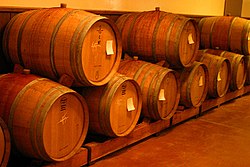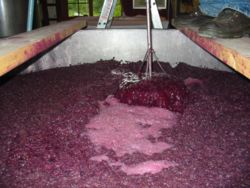A
- Acetaldehyde
- The main aldehyde found in wines, most notably Sherry.
- Acetic acid
- One of the primary volatile acids in wine.
- Acetification
- The process through which acetic acid is produced in wine.
- Acetobacter
- A bacterium found in wine that causes acetification resulting in the conversion of wine to vinegar.
- Acidity
- The quality of wine that gives it its crispiness and vitality. A proper balance of acidity must be struck with the other elements of a wine, or else the wine may be said to be too sharp – having disproportionately high levels of acidity – or too flat – having disproportionately low levels of acidity. The three main acids found in wine are tartaric acid, malic acid and lactic acid. The first two come from the grapes and the third from Malolactic fermentation which often occurs in the winemaking process.
- Active acidity
- The concentration of acids in the wine. Used to gauge the "total acidity" in the wine. Measured using the pH scale.
- Actual alcohol
- The amount of ethanol present in wine, usually measured as a percent of total volume (ABV) taken at 20°C
- Aerobic conditions
- Winemaking conditions that promote exposure to oxygen, such wine barrels kept partially full in order to oxidatively age the wine

- Aging barrel
- A barrel, often made of oak, used to age wine or distilled spirits.
- Alcohol
- Generally refers to ethanol, a chemical compound found in alcoholic beverages. It is also commonly used to refer to alcoholic beverages in general.
- Alcoholic fermentation
- The conversion by yeast of sugar into alcohol compounds
- Aldehyde
- A component of wine that is formed during the oxidation of alcohol. It is midway between an acid and an alcohol.
- Alternative wine closures
- Various substitutes used in the wine industry for sealing wine bottles in place of traditional cork closures.
- Amino acids
- Protein found in wine grapes that are formed by fruit esters and consumed during the fermentation process and/or autolysis. They contribute to the sense of complexity in a wine.
- Amphora
- A type of ceramic vase, used for transporting and storing wine in ancient times.
- Anaerobic
- The opposite of aerobic, referring to a chemical process that takes place in the absence of oxygen. As a wine ages in a sealed wine bottle, it is going through anaerobic changes.
- Analyzer
- The first column in a Coffey still, outlawed for the production of Cognac but can be used in other regions for wine-based spirits, where the pre-heated wash is vaporized by steam
- Angel's share
- The portion of a wine in an aging barrel that is lost to evaporation.
- Anreicherung
- German winemaking term for must enrichment
- Anthocyanin
- Phenolic pigments that give red wine its color.
- Antioxidant
- Chemicals, such as sulfur dioxide, that are used to prevent the grape must from oxidizing.
- Aromatized wine
- A wine that has been flavored with herbs, fruit, flowers and spices. Examples: Vermouth, Retsina or mulled wine.
- Ascorbic acid
- An antioxidant used to prevent grape must from oxidizing.
- Aseptic
- The characteristic of a chemical (like sulfur dioxide or sorbic acid) to kill unwanted or beneficial bacteria.
- Assemblage
- The blending of base wines in order to create a final blend or cuvee.
- Atmosphere
- The measure of atmospheric pressure within a wine bottle. The average internal pressure inside a bottle of sparkling wine is 6 atmospheres.
- Autolysis
- The breakdown of dead yeast cells (or lees) and the process through which desirable or undesirable traits maybe imparted to the wine. Wines that are deliberately aged sur lie such as Muscadet or some white Burgundies derive certain flavors and textures from this process.
